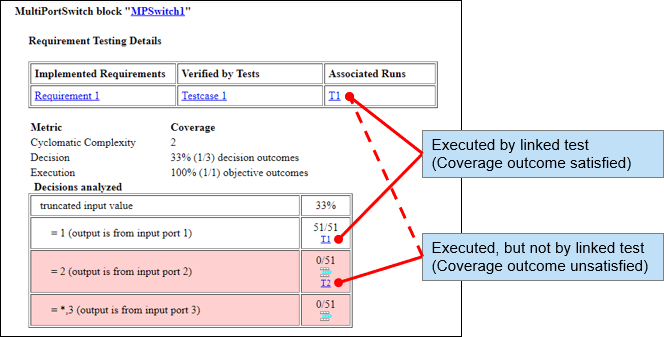评估基于需求的测试的覆盖率结果
您可以从 Simulink® Test™ 中的测试管理器将覆盖率结果范围限定到基于需求的链接测试。聚合覆盖率结果的范围是,每个测试仅为实现该测试验证的需求的相应模型元素提供覆盖率。
将覆盖率结果范围限定到基于需求的链接测试的理由
如果基于模型的设计工作流程需求模型完全通过基于需求的测试,那么您可以将覆盖率限制为仅通过基于需求的测试的结果。例如,DO-178C 建议基于需求的测试期间收集的结构覆盖率信息应确认结构覆盖率的程度适当并满足软件需求。当您启用将覆盖率结果限定为链接需求时,聚合覆盖率结果的范围是,每个测试仅为实现该测试验证的需求的相应模型元素提供覆盖率。
您可以定义需求并使用 Requirements Toolbox™ 将其链接到模型元素和测试。将覆盖率范围限定到链接需求,可以让您提供证据,证明模型覆盖率来自预期的基于需求的测试,而不是不相关测试的副作用。将覆盖率结果限定到链接需求还可以揭示出需求链接不足或测试差距,而这些差距在聚合覆盖率结果中可能很难被发现。
将覆盖率结果范围限定到基于需求的链接测试的前提条件
要将覆盖率结果限定在链接需求范围内,您必须:
拥有 Simulink Test 和 Simulink Coverage™ 的许可证。
将 Requirements Toolbox 中的需求链接到模型元素,并将 Simulink Test 中的测试用例到验证需求。有关创建需求链接的更多信息,请参阅在 Simulink 中查看和链接需求 (Requirements Toolbox)。
注意
如果没有 Requirements Toolbox 许可证,您就无法创建或编辑需求链接,也无法查看有关需求的详细信息。
使用 Simulink Test 中的测试管理器收集覆盖率,并启用将覆盖率结果限定为链接需求以获取聚合覆盖率结果。有关在 Simulink Test 中的测试管理器中设置覆盖率收集的更多信息,请参阅收集测试覆盖率 (Simulink Test)。
针对链接需求的聚合覆盖率结果的覆盖率报告
以下覆盖率报告显示了名为 MPSwitch1 的 MultiPortSwitch 模块的需求测试详细信息和覆盖率详细信息。

在上面的示例中,MPSwitch1 实现了需求 1,并通过测试用例 1 进行了验证。因此,测试用例 1 尝试为 MPSwitch1 提供全覆盖。将覆盖率结果范围限定到链接需求,可以在查看聚合覆盖率结果时更轻松地评估测试用例 1 对 MPSwitch1 的执行程度。
第一个决策结果由测试用例 1 成功执行,并报告为满意。第二个决策结果不是由测试用例 1 执行的,而是由与需求 1 无关的测试得出的。因此,覆盖率报告认为该决策不令人满意。
第三个决策结果未经任何测试执行,因此报告为不满意。
示例
有关如何从 Simulink Test 中的测试管理器将覆盖率结果范围限定到链接需求的示例,请参阅基于需求的测试的测试覆盖率 (Simulink Test)。
另请参阅
主题
- 在 Simulink 中查看和链接需求 (Requirements Toolbox)
- 收集测试覆盖率 (Simulink Test)